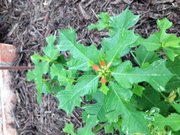Q About 10 years ago, I planted nearly 100 surprise lilies in my yard, and they have bloomed beautifully every year since -- until this year. In the spring, the leaves came up and grew quite well. They were taller and fuller than ever before. But now, I've only got about 10 blooms total. Where did the flowers go? Are the plants dead, or will they come up next year (and, hopefully, bloom)?
A The pink surprise lily you are talking about is a type of Lycoris -- Lycoris squamigera. The foliage emerges in the spring, grows for several weeks, dies back and then the naked stems (just stems with no leaves) with pink blooms emerge in late summer. They are often referred to as Naked Ladies. The other form is the red spidery blooming form often called surprise lily. It is Lycoris radiata and its foliage comes up in the fall after it blooms, grows all winter and dies in the spring to emerge in the early fall. Typically, the red ones will skip a season of blooms more frequently than the pink ones, especially if we have a hard winter and the foliage doesn't survive the winter. We have had an erratic growing season, but since your foliage did well, I am surprised they haven't bloomed. Did the foliage die back naturally, or did someone cut it back early? I would be surprised if they are dead. It is possible they are delayed and you may have some later blooms, so wait and see what happens, and even without an appearance this year I would wait until next spring and see what comes up.
Q Reading your recent article, I wonder if the weed (Virginia buttonweed) is the weed that I have been fighting in our lawn for years. The weed that shows up in our lawn and neighbors' lawns has a white and sticky stuff ooze out of a stem if you break it. I refer to it as the "milk weed." The white milky stuff turns black on your fingers. It has one long root. A yard man told my neighbor that the only thing that he knows that will kill it is Roundup. I thought maybe the milky stuff would help you identify it and what to use to get rid of it.
A We have three different weeds to talk about. The weed you sent me a picture of is spurge (Euphorbia). This ground-hugging annual weed tends to grow where the soil is compacted and bare. It does contain a milky sap but is not commonly called milkweed. The milkweed family with large showy orange, pink, white or yellow flowers (Asclepias) also contains a milky sap except for the butterfly weed Asclepias tuberosa -- the only member of the milkweed family without a milky sap. Have I confused you yet? Most members of the Asclepias family are large perennial plants, not ground-hugging like your annual spurge. Virginia buttonweed is a perennial weed with larger leaves than your spurge, and is much more difficult to kill than spurge. Spurge is typically fairly easy to pull by hand or scrape off with a sharp hoe. It has a rosette of foliage that radiates out. If you can mulch your bare soil or get a thick stand of turf, you shouldn't have as many issues with it. It doesn't compete well with other plants.
Q I have strawberries in my front garden that I want to move to my vegetable garden. When and how can I do that?
A You have two options. Wait until the cooler days of fall and then move them, trying to get them re-established so you can still have fruit next spring, or wait until after you harvest the fruit next spring, then renovate, thin and replant. Strawberries really should be divided and thinned back every year following harvest.
Q My mother inherited seeds of this plant from her aunt years ago. She was told it is a form of poinsettia. It reseeds itself every year. Have you seen this plant before and if so, can you tell us what it is?
A The plant in question is commonly called summer poinsettia, wild poinsettia or Fire on the Mountain -- Euphorbia cyathophora. It is in the same family as the Christmas poinsettia, but this one is an annual that reseeds itself in the garden. Some call it a wildflower and enjoy it, while others think it gets a bit weedy. I enjoy the color late in the season. It does have a milky sap like other euphorbias.
Janet B. Carson is a horticulture specialist for the University of Arkansas Cooperative Extension Service. Write to her at 2301 S. University Ave., Little Rock, Ark. 72204 or email her at
jcarson@arkansasonline.com
HomeStyle on 08/22/2015

